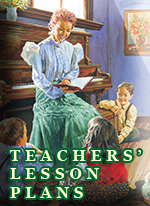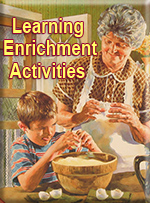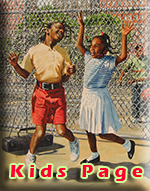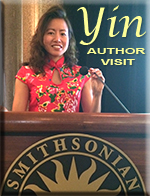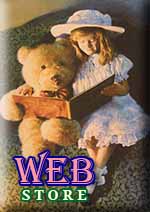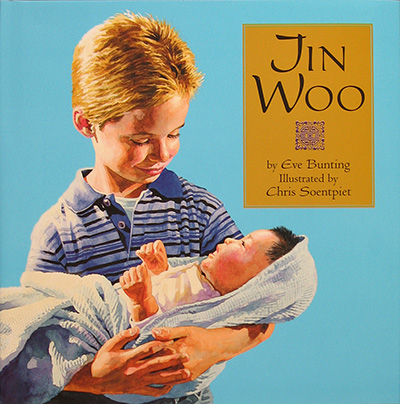|

ABOUT THIS BOOK:
David
likes his family the way it has always been, just him and Mom and Dad.
He never wanted to be a big brother. And he certainly never invited Jin
Woo, the little baby from Korea, to become a part of the family. Now Jin
Woo is getting all the attention, and David feels as if no one cares about
him anymore. But then a surprising letter helps him to understand that
being a brother can mean being surrounded with more love than ever.
MY THOUGHTS OF “JIN WOO”:
I was honored when Eve Bunting chose me illustrate this story.
Adoption has a special place in my heart as I was adopted just like JIN WOO. -Chris
Soentpiet
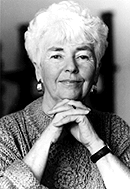 |
Eve Bunting has received many awards, including the Golden Kite Award from the Society of Children's Book Writers and Illustrators in 1976 for One More Flight (Warne). In 1995 the Caldecott Medal was presented to David Diaz for his illustrations for her Smoky Night (Harcourt). Ms. Bunting has taught several writing classes, including one at the University of California, Los Angeles. She lives with her husband in Pasadena, California.
Eve Bunting and Chris Soentpiet bring the
same deep emotion that distinguished their previous collaboration, SO
FAR FROM THE SEA, to this moving story about an adoptive family
that has love to spare.
|

BOOK
REVIEW:
Among the prolific Bunting's many talents
in a propensity for distilling complex social issues into accessible picture
books that begin to make subjects such as the Vietnam Veterans Memorial,
adult illiteracy, and homelessness more understandable to younger children.
This picture-book exploration of the arrival of an adopted Korean baby
named Jin Woo is the second collaboration by Bunting and Soentpiet, and
as a Korean adoptee himself, the talented Soentpiet is particularly well
qualified to illustrate this one. Jin Woo's story is told in the present
tense from the viewpoint of the baby's older brother, a six or seven-year
old named David, who is also adopted. He is alternately sad, hopeful,
unbelieving, and excited at this change in his life, which is an accurate
portrayal of the whirlwind of feelings that surround any new big brother.
David's parents are understandably thrilled, with their joyous emotions
captured in both Bunting's text and in Soentpiet's detailed, realistic
paintings. His large-format illustrations are the book's main strength,
surpassing Bunting's serviceable story, which is not as compelling as
some of her other picture book texts. There are some wonderful recent
books on inter-country adoption (notably Rose A. Lewis's I Love You Like
Crazy Cakes, 2000), but very few that focus on the mixed feelings of older
siblings. This will find a ready audience with many adoptive families,
especially those preparing to adopt babies.
-KIRKUS REVIEWS
Jin Woo is the baby that's coming from Korea
to be adopted by David's family, but David's not sure how he feels about
having a little brother. The night before Jin Woo's arrival, the family
goes to a Korean restaurant. The next day, they pick up the baby at the
airport, where David gets to hold the chubby, happy child. When his mother
reads him a comforting letter "written" by Jin Woo, David feels things
will work out after all. The story's climax comes when David decides to
give his brother the duck mobile that spins over his bed. The art is the
high point of this solid piece of bibliotherapy. It has photographic clarity
that makes these characters real enough to touch, and adorable Jin Woo
looks eminently huggable. A solid choice for adoption shelves, especially
for those looking for material on international adoption.
-BOOKLIST

|
(this guide was adapted by the North Carolina Children's Book Award Committee)
Theme: JIN WOO can be used to introduce your students to
the Korean- Americans, adoption, sibling rivalry.
Pre-reading:
Show the students the cover of the book, read the title, author
and illustrators name. Ask them what they think the book will be
about. Next show the illustration of the kitchen scene with David
looking down and unhappy -- now what do they think the book will
be about. Have the students look at a globe or world map to locate
Korea.
Reading:
As you read and show the illustrations have the students look closely
at the drawings. What details can they find in the pictures? Have
them look closely at the expressions on the faces of the characters
-- how do they change throughout the story. Ask the students how they
think the characters are feeling. Can they tell by the illustrations?
Interview:
If possible talk with a Korean-American, an adoptee (or relative
of the adoptee) -then write their story. Talk with someone who was
adopted. Ask a parent, a grandparent or a friend.
Language Arts/Communication Skills:
- Have students imagine that David is a little older and able to write and express his thoughts. Have them write some journal/diary entries as if they were expressing his feelings before the baby comes, during his time at the airport, and after a few years.
Social Studies/Community Involvement:
- November is National Adoption Month. Plan a story time focused on adoption. Read other books on adoption such as I love you like Crazy Cakes. Invite speakers form your community (include parents, students, faculty members, community agencies) to speak to the PTA or your classes highlighting the adoption process. Visit adoptmonth.ca.lib.com for further information on National Adoption Month.
- Locate Korea on a globe or map. Discuss ways to travel to and from Korea. What will they bring with them? Calculate how many miles the baby traveled to come to the USA.
- Research Korean customs as mentioned in the story. Share orally.
Music/Art:
- Listen to traditional Korean music.
- Compare Soentpiet's style of illustration to Norman Rockwell.
- The Korean traditional dress like the honbok is worn when the baby
turns one year old. Make a life-size paper doll. Have students making
tracings of the honbok. Now have the students color it with crayons,
watercolors, acrylic or decorate their honbok with scraps of paper,
fabric, yarn, and other craft items.
Science:
The family dines at a Korean restaurant. What type of Korean
food might the family require to meet the food pyramid requirement?
Hint you should get a menu from a Korean restaurant to help you.
Use the internet to find a Korean restaurant menu.
Farms and farming
-- where does the Korean food come from? What is a rice paddy? Try
growing plants in a variety of ways -- soil, hydroponics etc. keep
a journal of their growth.
Social Studies:
Jin Woo immigrated to the United States to be with his new family.
Talk about immigration -- are there any immigrants in the class
-- list the countries of each student's ancestry.
Make a guidebook
to Korea -- cover topics like cities, geographical features, customs,
traditions, folklore, early history, food, games, traditional dress
like the honbok.
Literature:
Read another book about Korea, adoption or sibling rivalry. Suggested
reading: PEACEBOUND TRAINS by Haemi Balgassi,
GOOD
AS GOLDIE by Margie Palatini, I
LOVE YOU LIKE CRAZY CAKES by Rose A. Lewis, OVER
THE MOON by Karen Katz, "A"
IS FOR ADOPTED by Eileen Tucker Cosby. Look for other books
by Eve Bunting and Chris Soentpiet. If you really enjoyed JIN
WOO write a review and post it on-line at Amazon.com
or Barnesandnoble.com
so others can enjoy your reading experience.
Bulletin
Board - David generously gave away his precious ducks which
he loved so much to Jin Woo. Bring a baby mobile or some rubber
ducks to symbolize David's kind gesture. Ask each student, what
personal items they would give away if they were expecting a little
baby into their family. List them.
|
paper duck inspired by "Jin Woo"
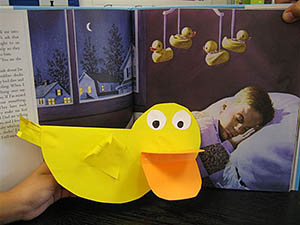
|
|
